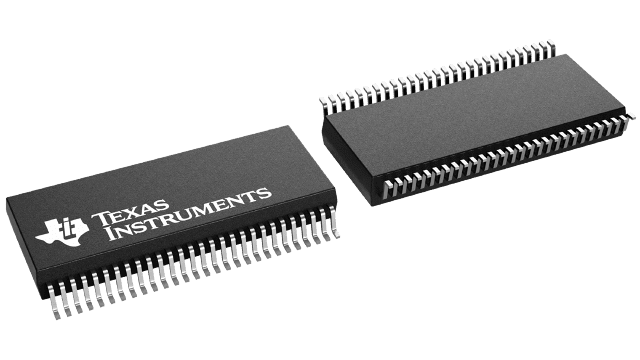Packaging information
| Package | Pins SSOP (DL) | 56 |
| Operating temperature range (°C) -40 to 85 |
| Package qty | Carrier 20 | TUBE |
Features for the SN74GTL16612
- Members of Texas Instruments' Widebus™ Family
- UBT™ Transceivers Combine D-Type Latches and D-Type Flip-Flops for Operation in Transparent, Latched, Clocked, or Clock-Enabled Modes
- OEC™ Circuitry Improves Signal Integrity and Reduces Electromagnetic Interference
- Translate Between GTL/GTL+ Signal Levels and LVTTL Logic Levels
- Support Mixed-Mode (3.3 V and 5 V) Signal Operation on A-Port and Control Inputs
- Identical to \x9216601 Function
- Ioff Supports Partial-Power-Down Mode Operation
- Bus Hold on Data Inputs Eliminates the Need for External Pullup/Pulldown Resistors on A Port
- Distributed VCC and GND Pins Minimize High-Speed Switching Noise
- Latch-Up Performance Exceeds 500 mA Per JESD 17
OEC, UBT, and Widebus are trademarks of Texas Instruments.
Description for the SN74GTL16612
The 'GTL16612 devices are 18-bit UBT™ transceivers that provide LVTTL-to-GTL/GTL+ and GTL/GTL+-to-LVTTL signal-level translation. They combine D-type flip-flops and D-type latches to allow for transparent, latched, clocked, and clock-enabled modes of data transfer identical to the '16601 function. The devices provide an interface between cards operating at LVTTL logic levels and a backplane operating at GTL/GTL+ signal levels. Higher-speed operation is a direct result of the reduced output swing (<1 V), reduced input threshold levels, and OEC™ circuitry.
The user has the flexibility of using these devices at either GTL (VTT = 1.2 V and VREF = 0.8 V) or the preferred higher noise margin GTL+ (VTT = 1.5 V and VREF = 1 V) signal levels. GTL+ is the Texas Instruments derivative of the Gunning Transceiver Logic (GTL) JEDEC standard JESD 8-3. The B port normally operates at GTL or GTL+ signal levels, while the A-port and control inputs are compatible with LVTTL logic levels and are 5-V tolerant. VREF is the reference input voltage for the B port.
VCC (5 V) supplies the internal and GTL circuitry while VCC (3.3 V) supplies the LVTTL output buffers.
Data flow in each direction is controlled by output-enable (OEAB\ and OEBA\), latch-enable(LEAB and LEBA), and clock (CLKAB and CLKBA) inputs. The clock can be controlled by the clock-enable (CEAB\ and CEBA\) inputs. For A-to-B data flow, the devices operate in the transparent mode when LEAB is high. When LEAB is low, the A data is latched if CEAB\ is low and CLKAB is held at a high or low logic level. If LEAB is low, the A data is stored in the latch/flip-flop on the low-to-high transition of CLKAB if CEAB\ also is low. When OEAB\ is low, the outputs are active. When OEAB\ is high, the outputs are in the high-impedance state. Data flow for B to A is similar to that for A to B, but uses OEBA\, LEBA, CLKBA, and CEBA\.
These devices are fully specified for partial-power-down applications using Ioff. The Ioff circuitry disables the outputs, preventing damaging current backflow through the device when it is powered down.
Active bus-hold circuitry holds unused or undriven LVTTL inputs at a valid logic state. Use of pullup or pulldown resistors with the bus-hold circuitry is not recommended.
